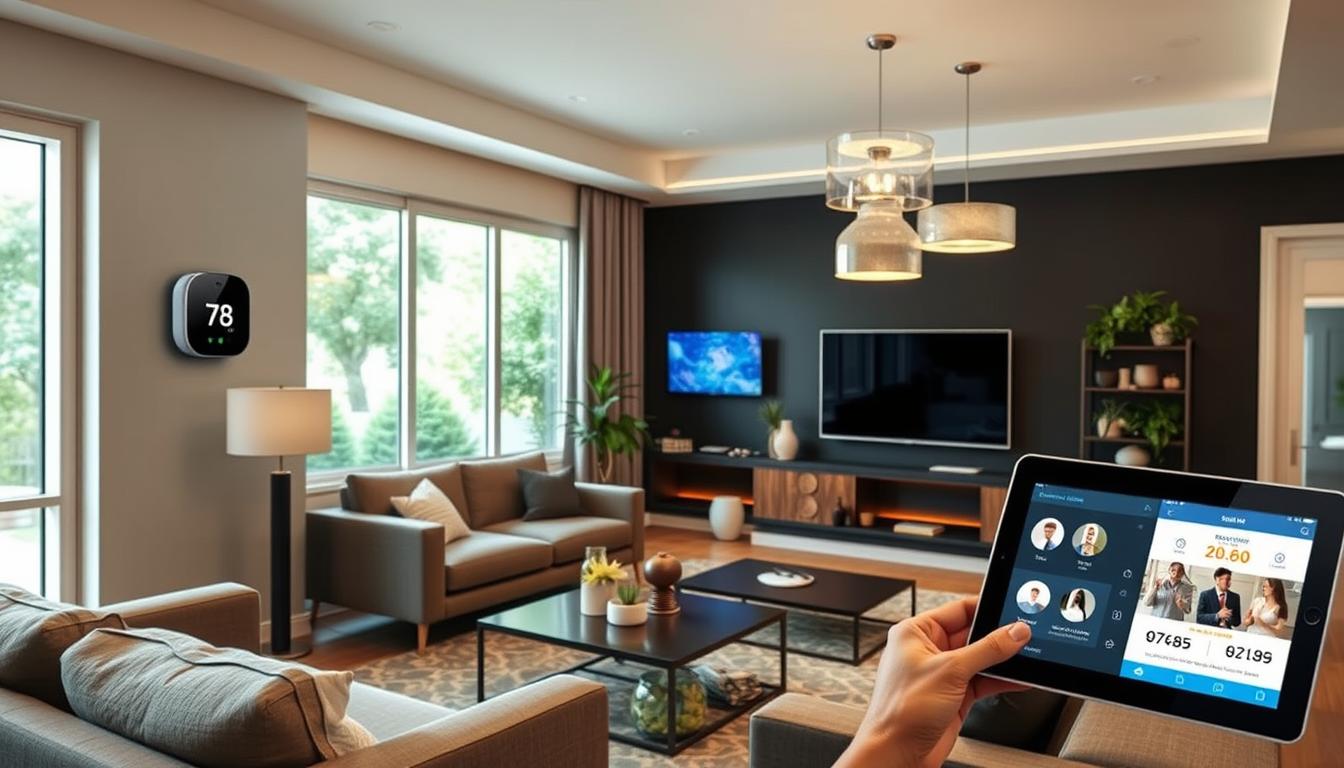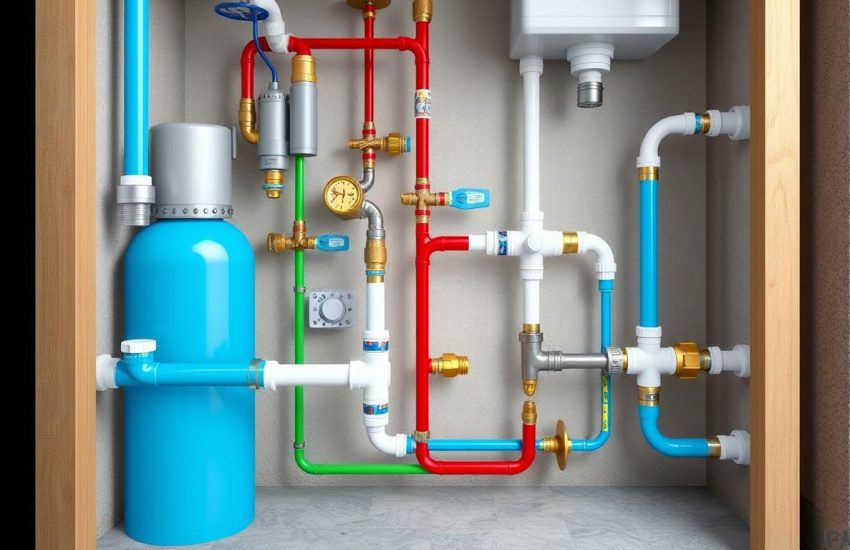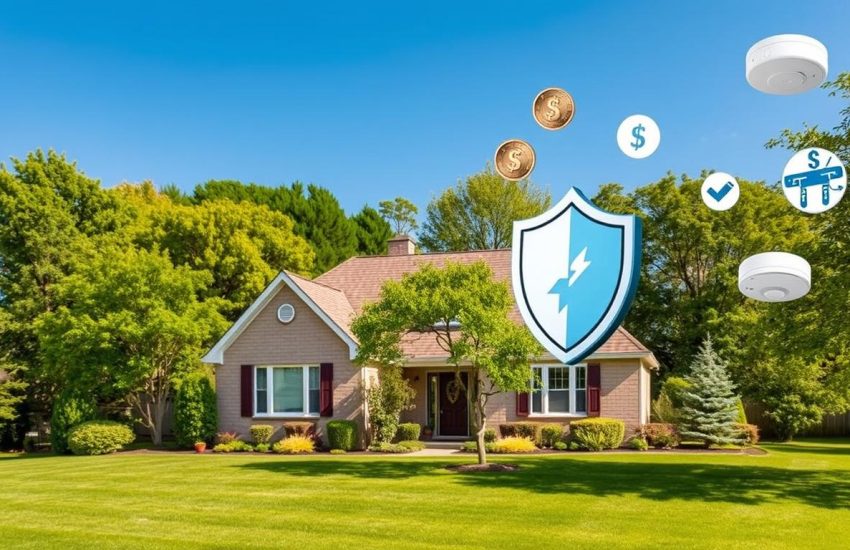Smart Home Technology: A Complete Guide for Homeowners
Smart home technology was once only in science fiction. Now, it’s a big part of our lives. It’s booming, with spending hitting 127 billion USD. More than half of US homes will use this tech by the end of 2023. It’s not just a trend. It’s changing how we manage our homes, save energy, and keep safe.
Smart homes are growing fast worldwide, aiming to reach 481.9 million by 2025. This shows how much people love controlling their homes with just a phone. 77% of people say it makes life better. It helps with daily tasks, saves money, and gives peace of mind. This guide will show you how to make your home smart and comfy.
Key Takeaways
- Global smart home market value is on the precipice of exceeding 135 billion USD by 2025, signifying major growth.
- In 2023 alone, 60.4 million US homes have smart devices at their command, steering towards a more tech-driven domestic life.
- Smart thermostats exemplify this tech surge with a 30% yearly growth rate since 2018—evidence of the push for energy efficiency.
- Accessibility and convenience are not mere buzzwords; they’re tangible benefits as smart homes cater to individuals of all abilities.
- With ecosystems like Apple HomeKit, Google Assistant, and Amazon Alexa, smart home integration has never been smoother or more flexible.
- The DIY versus professional help debate continues, balancing customization against the expertise for optimal smart home set-up.
- Smart home technology isn’t just for the elite—its growing affordability ensures it’s a viable option for a broader demographic.
Why Focus on Smart Home Technology?
Smart home technology is big in modern home upgrades. It mixes comfort, saves energy, and has cool features. It changes how we live. It makes our homes efficient, safe, and cozy.
The benefits of smart home technology are huge. They help save a lot of energy and keep our homes safe. Smart gadgets like thermostats and lights cut down on energy use. This lowers our bills.
| Features | Consumer Concerns | Cost Implications |
|---|---|---|
| Smart Thermostats, Lighting | Data Security (72% concern) | Starting below $100 |
| Comprehensive Systems | Device Security (55% concern) | Up to several thousand dollars |
At first, setting up a smart home can cost up to $15,000. But, the savings and better lifestyle make it worth it. Also, prices are dropping, so now is a good time to upgrade.
Some people worry about their data’s security. But top brands are making their gadgets safer. Choosing products from known brands like Google and Amazon helps. It makes enjoying smart home benefits worry-free.
To wrap up, smart home tech is more than a trend. It’s about making home life better with smart, secure, and energy-saving upgrades.
DIY vs Professional Help
Deciding between DIY smart home technology and professional installation needs careful thought. You must balance the joy of making it your own with the need for expertise. About 48 connected devices are in the typical home, making smart systems popular but complex.
DIY installations draw people with their low initial costs. They offer a chance to learn about tech and automation hands-on. You get to control everything and make it fit your style. Yet, 22% of smart devices are returned because setting them up is hard. Knowing about networks and device matching is important.
On the other hand, professional installation comes with expert help. Companies like Best Buy and Amazon Smart Home Services offer it. Also, local firms like Goodman Networks do too. Their staff get a lot of training (about four to six weeks). They can handle complex setups, like the Control4 Smart Home OS, that work with almost 14,000 devices.
| Installation Type | Key Advantages | Considerations |
|---|---|---|
| DIY Smart Home Technology | Lower costs, customization, hands-on learning | Requires technical knowledge, higher risk of setup errors |
| Professional Installation | Expert setup, seamless integration, ongoing support | Higher upfront costs, dependent on contractor schedules |
Sometimes, a mix of DIY and pro help is best. Tackle easy jobs yourself. Let experts do the hard parts. This way, you get a bit of both: your touch and their know-how.
Picking a path? Look at homeowner tips and tutorials first. They help you make wise choices and improve your smart home well.
How to Save Money
Exploring smart home technology opens ways to save money. It also makes your home more energy efficient. This mix of tech and modern living saves you money in the long run. Especially with energy-efficient devices.
Using LED lights saves about $225 a year. This shows how good energy-saving lights can be. Smart thermostats adjust the heat to save you money. They lower your bills by working less when you don’t need them to.
Energy efficiency helps homeowners spend less. By having devices work together, your home uses less energy. It also makes your devices last longer. Keeping them updated is key.
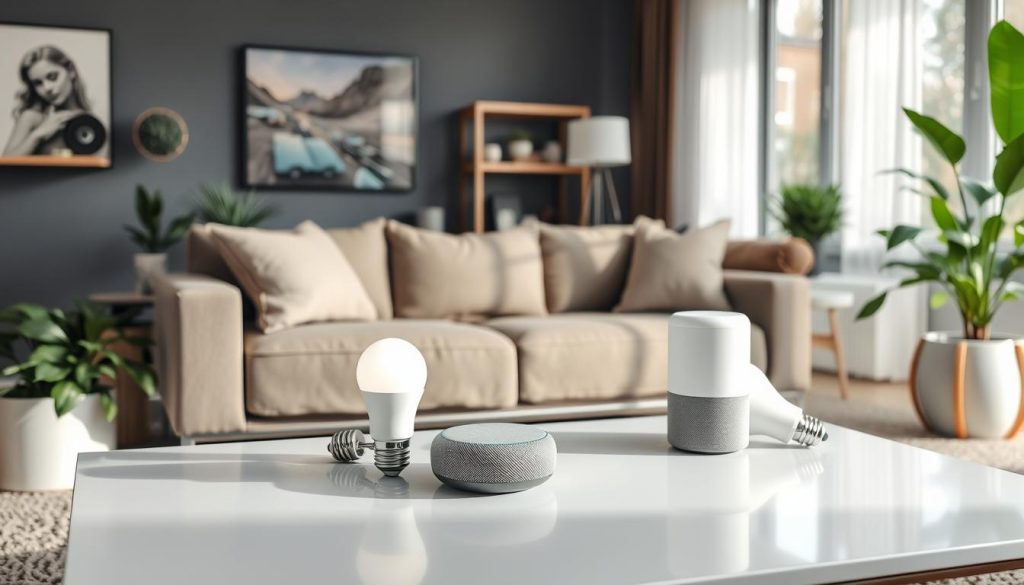
- Pick devices with Energy Star certification for better energy use.
- Keep an eye on your energy use with smart home apps.
- Think about using clean energy to lower your home’s energy use.
Smart tech like leak detectors and secure systems prevent expensive problems. They may also lower insurance costs, which saves money indirectly.
The use of smart home tech in houses around the world is increasing. See here. Upgrading now is smart. These changes raise your home’s value and cut energy bills.
So, think about getting smart plugs, heat mapping, or better security. Smart home improvements are great for your wallet and the Earth. They make your home more efficient and save on bills. Plus, they’re good for living green.
Step-by-Step Upgrades
Starting to make your home smart requires careful picks and setting up. You should get to know the top systems: Google Home, Amazon Alexa, and Apple HomeKit. Each of them has its own strengths to suit different wants and needs.
Amazon Alexa offers a huge selection of devices and extra Skills, great for those who want lots of options. Google Home shines with speedy answers from Google Assistant and works well with Android gadgets. Apple HomeKit is best for Apple users, offering secure use and easy pairing with iOS devices.
First, check what your home can already handle, including the tech and internet connection. Most new routers support many devices, often up to 250. But remember, Wi-Fi traffic on 2.4 GHz and 5 GHz bands can get crowded, and that might slow things down.
Setting up a smart home usually begins with key items: speakers, lights, thermostats, and security. For example, a smart thermostat saves money by using less energy and connects with other tech for better use. Adding smart security cameras means picking the best spots and hooking them up to your network and main control point.
Think about how different devices and systems work together. Nowadays, most smart tech works with various voice helpers like Alexa, Google Assistant, and Siri. This mix-and-match ability lets you control your home in more ways.
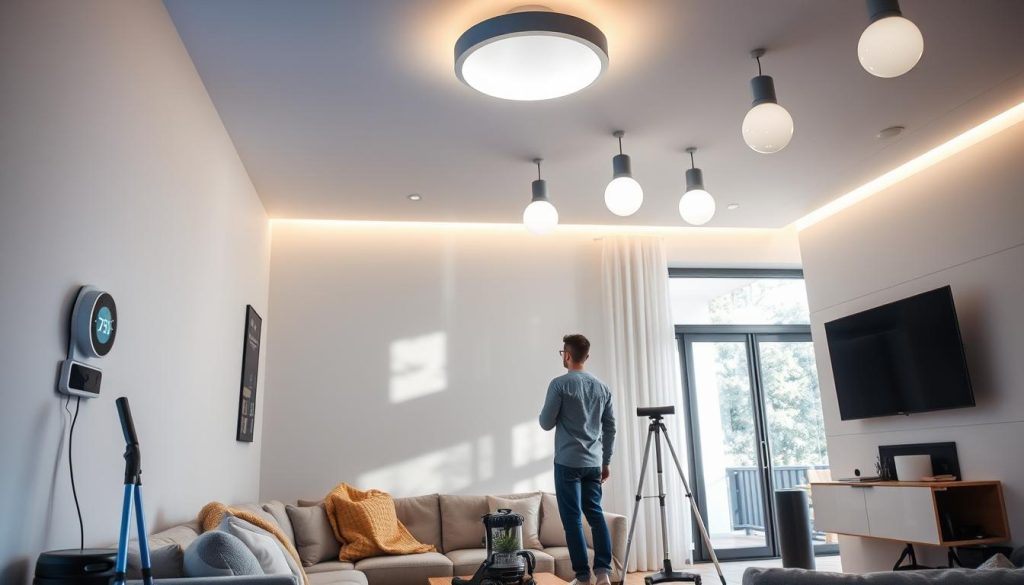
| Ecosystem | Key Advantages | Popular Devices | Connection Types |
|---|---|---|---|
| Google Home | Fast voice command response, Android compatibility | Google Nest Hub, Smart Lights | Wi-Fi, Thread |
| Amazon Alexa | Wide range product compatibility, third-party Skill support | Amazon Echo, Smart Plugs | Wi-Fi, Zigbee |
| Apple HomeKit | Secure and seamless iOS integration | Home Pod, Smart Locks | Wi-Fi, Bluetooth |
To smoothly shift to a smart home, first add key devices and then slowly introduce more. Starting with main hubs and essential devices lets you grow your setup as you like. This approach leads to a fully linked and efficient home automation system.
Final Tips for Success
When you start with smart home integration, remember this. The success doesn’t just come from installing devices. It also comes from keeping everything updated and choosing smart tech wisely. Having strong Wi-Fi security is crucial to keep safe from unwanted access. It’s also important that all your gadgets work well together.
Think about how much energy your home uses. Smart thermostats save energy by keeping the temperature just right. Motorized window shades adjust with the sun to help save energy. Smart bulbs last longer and use less energy than regular bulbs. For top security, use more than one way to prove it’s really you trying to get in. Keep your devices up to date. Use a strong password and a VPN for more safety.
Having a smart home is more than saving money or making things work better. It’s about living a better life. With voice commands, you can control your home from far away. The smart home market is growing fast. By 2025, it could be worth $97.61 billion. So, stay updated on new technology. Choose devices that fit your needs, not just the latest gadgets. Pick smart appliances and security systems that make your life easier and safer. By focusing on useful tech, you make your home better and your life easier.

